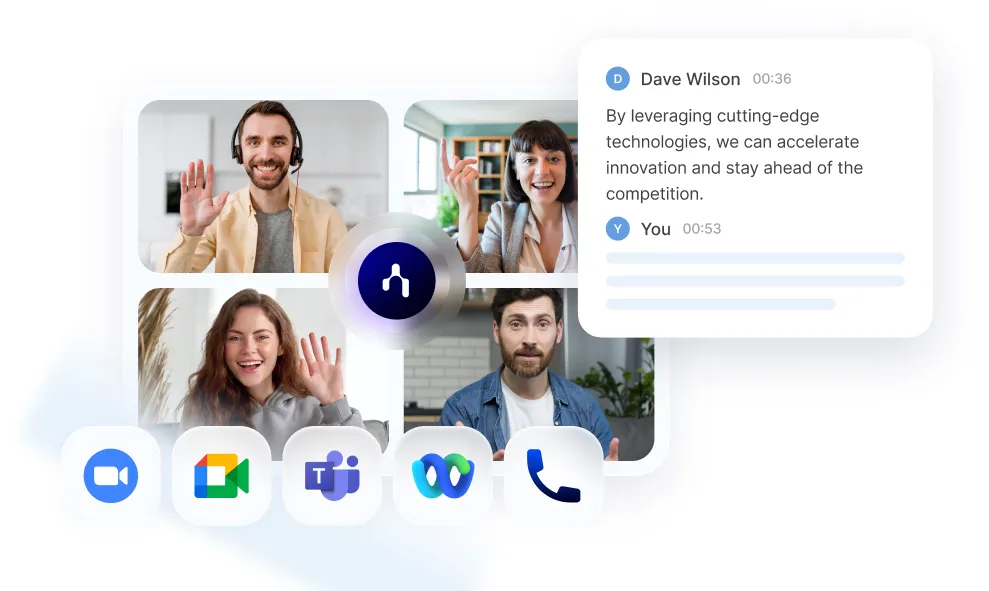Information Silos : What You Need to Know

Get the work done for any meeting
Meeting transcription, AI custom notes, CRM/ATS integration, and more
Information silos quietly drain energy and clarity from your organization.
The reality is that silos don’t just live in software. They live in habits.
In this guide, you’ll learn what information silos are and practical strategies to minimize the.
What Is an Information Silo?
An information silo is a structural or cultural barrier that prevents data, knowledge, or insights from being shared freely across teams, departments, or tools.
In other words: useful information is trapped, enclosed, and inaccessible to those who need it.
The Silo Metaphor
Think of a grain silo: tall, insulated, and singular in purpose. You store grain there, but the silo doesn’t let the grain spill out to neighbouring silos. That’s how information silos behave: the data inside is “stacked high,” but it doesn’t move outward into useful cross-team contexts.
Information silos don’t always appear overnight. They arise from multiple factors, often reinforcing each other :
- Technological incompatibility. Teams use different platforms, CRMs, analytics tools, or databases with limited or no integration. That separation prevents cross-system queries or unified views of data.
- Departmental autonomy & misaligned incentives. When units make decisions or collect data independently, they may not see the value in sharing, or they may even hoard it for perceived competitive advantage.
- Cultural resistance or “silo mentality.” Even when systems are integrated, people sometimes default to working within their own domain, either out of habit, fear of judgment, or lack of trust.
- Mergers, legacy systems, or rapid growth. When organizations scale fast or combine with others, multiple systems may be adopted without unified planning, preserving old silos.
- Lack of data governance. When there is no clear owner, policy, or schema for the “single source of truth,” each team may develop its own version of data.
Symptoms of Information Silos in Your Company

If information silos are walls keeping insights locked away, symptoms are the cracks and stains you begin to see over time.
2.1 Conflicting Goals & Misaligned Measures
When different teams carry targets and KPIs that don’t align—or worse, work at odds—you may already be siloed. APQC identifies “conflicting goals” as a core symptom: teams optimize their own function rather than pursuing a shared outcome.
For example, marketing might be rewarded on lead volume while sales is judged by conversion rates without regard to lead quality. Each unit optimizes in isolation, potentially undercutting overall business performance.
2.2 Redundant Projects & Duplicate Work
One team is doing a data analysis, another is doing nearly the same — without realizing the overlap. That’s a sign there is no shared transparency. APQC notes redundant or overlapping projects as another symptom of silos.
In practice, duplication drains resources and breeds frustration. Teams wonder why their peers “reinvented the wheel,” while leadership wonders why cross-department synergy never materializes.
2.3 Multiple Disconnected Systems & Data Stores
Silos also manifest in your tech stack. If one team uses a CRM, another works in a separate database, and none of them talk, you’ve built digital walls. Information stored in incompatible or isolated systems is a classic definition of data silos.
This fragmentation prevents pulling unified insights—customer journeys, metrics, or content performance—across domains. You end up with scattered dashboards, stale reports, and conflicting versions of truth.
2.4 “Us vs. Them” Mentality & Blame Culture
When silos become cultural, the language changes. You hear comments like, “That’s sales’ problem,” or “Ask the product team”—instead of “Let’s figure it out together.” CMSWire highlights this “us vs. them” mentality as a signal that departments see each other as competing fiefdoms rather than collaborators.
Blame becomes a default response instead of cross-team problem solving. Not surprisingly, morale suffers and collaboration dries up.
2.5 Fragmented Customer Experience
If customers hear different brand stories or witness inconsistent messaging as they touch marketing, support, and product, your internal silos are at work. CMSWire calls broken customer experience a key red flag: when departments don’t share data or context, the external experience fractures.
For example: marketing positions a feature one way, but product documentation frames it differently. Or support isn’t aware of the latest release, so user questions come back with outdated answers.
2.6 Isolated Communication & Poor Cross-Team Visibility
When teams can’t answer basic questions about what other teams are doing, you have a communication silo. Flock Associates lists limited cross-communication as one of its “7 signs your organization is working in silos.”
If employees can’t name counterparts in other departments or don’t know their priorities, you lose the richness of shared awareness. Teams drift apart instead of moving in sync.
2.7 Disenfranchised Employees & Information Hoarding
People feel invisible or undervalued when they’re excluded from the flow of information. Flock points to disenfranchisement—team members feeling unsupported or out of the loop—as a symptom.
Sometimes this leads to knowledge hoarding: individuals or subgroups store their insights privately, either for control, perceived job security, or because they simply don’t have channels to share.
2.8 Bottlenecks in Handoffs & Delay in Decisions
Because one team doesn’t have direct access to another’s data, handoffs stall. Approvals get stuck, decisions wait for someone else’s context. Chronus calls reduced efficiency and delayed decisions consequences of organizational silos.
You might notice: “I’m waiting on legal or product to review,” or “I don’t have the data I need to move forward.” If those delays are recurring, you’ve got a process silo.
How to Minimize Information Silos in Your Organization

Breaking down silos takes deliberate interventions in structure, culture, processes, and tools. Below are practical strategies you can adopt now to reduce silos in your organization.
3.1 Secure Leadership Buy-In & Set a Unified Vision
Change almost always begins at the top. Leaders must not just endorse transparency — they must model it.
- Articulate a common vision. When all teams see how their work connects to a larger purpose, silo thinking weakens. Make cross-functional outcomes part of the narrative.
- Align metrics. Introduce shared goals or KPIs that cut across departments so each team doesn’t just optimize locally. (Virginia Mason’s “five tactics to collapse silos” emphasizes tying team goals to a shared metric)
- Sponsor cross-team projects. Let senior leadership pick a few strategic initiatives that require multiple departments to work together. That sets a precedent: siloes can be breached.
- Resource the change. Lending tools, time, or incentives to promote collaboration signals that the effort is real, not optional.
3.2 Establish Governance, Standards & a “Single Source of Truth”
Without structure, information sharing becomes ad hoc and chaotic.
- Create data governance standards. Define who owns what data, how it’s maintained, and how it’s shared. Inclusion from each department helps ensure buy-in.
- Designate a central repository or system of record. Whether it's a data warehouse, internal knowledge base, or integrated platform, have one place everyone can access. Several sources (e.g. Asana) call this a “central system of record” essential for breaking down silos.
- Standardize naming, taxonomy, and documentation. If each team calls things differently, merging or comparing info becomes error prone.
- Establish access policies. Use role-based permissions so teams can safely share what they need without exposing sensitive parts.
3.3 Facilitate Cross-Functional Communication & Rituals
Process is your ally. Rituals give structure to collaboration.
- Regular cross-team syncs. Weekly or biweekly check-ins between related functions (e.g., marketing + product, support + engineering) help maintain awareness.
- Joint planning workshops & retreats. Use quarterly offsite sessions to plan together, surface dependencies, and reinforce alignment.
- Communities of practice & guilds. Create interest groups (e.g., analytics, UX, operations) that cut across departments and meet regularly.
- Shadowing, rotations, or secondments. Let team members spend time in other teams to build empathy and understanding. (Runn.io suggests job shadowing and cross-team experiences as powerful anti-silo tactics)
- Use open communication tools. Shared Slack channels, cross-department forums, or organization-wide dashboards help surface context that otherwise stays hidden.
3.4 Integrate Systems & Automate Connectivity
If your systems can’t talk to each other, your people will struggle to either.
- Implement APIs, middleware, or connectors. Link CRMs, analytics tools, knowledge bases, project management systems, and more.
- Use integration platforms. Tools like Zapier, Make, or custom scripts can shuttle data across systems automatically.
- Adopt unified platforms. When possible, favor tools that combine features (e.g. knowledge + project + communication) so data lives in one ecosystem.
- Enable search across systems. Use tools or indexing layers that let you query across disparate silos.
- Audit and retire legacy silos. Legacy databases, isolated spreadsheets, or forgotten tools often are the root of new silos. Assess and phase them out.
3.5 Incentivize Sharing & Embed Accountability
You can’t expect people to share unless something encourages it.
- Tie rewards to collaboration. Make cross-team initiatives a factor in performance reviews, promotions, or recognition.
- Publicize sharing success stories. Celebrate when knowledge sharing leads to a win; use it as a model.
- Set internal “service level agreements.” E.g., team A will respond to cross-team data requests within X hours.
- Establish liaisons or integrators. Appoint “connectors” who ensure the flow of information between groups. (Some organizations assign departmental liaisons whose role is explicitly to share)
- Audit transparency. On a regular cadence, review which data assets are hidden, which ones are outdated, and who hasn’t shared recently. Use these audits to spark conversation.
3.6 Monitor, Iterate & Make It Part of Your DNA
Breaking silos isn’t a one-off project :
- Measure progress. Survey teams, track number of cross-team requests, monitor usage of shared repositories.
- Solicit feedback. Ask which bottlenecks still exist, where people still feel blocked, and iterate accordingly.
- Refine governance. As you evolve, your standards and access policies might need adjusting.
- Stay vigilant. Silos reappear as teams grow or reorganize. Continue running diagnostics.
- Institutionalize change. Embed “silo prevention” in onboarding, role descriptions, and team charters.
Desiloing Meeting Data: Noota

Your meetings are a goldmine of information — decisions, ideas, action items, context — but all too often, that data ends up locked in slides, chat threads, or a single person’s memory. Here’s how Noota can help you flatten those silos:
- Automatic transcription & indexing
Noota records or ingests meeting audio/video, transcribes it, and tags key content. It indexes across meetings so you can search past discussions. - Custom meeting summaries & templates
You can configure Noota to generate structured summaries that follow your format (e.g. decisions, action items, takeaways). That consistency makes it easier for people to scan, understand, and act. - Clip & highlight sharing
Noota’s AI can generate clips of key moments (quotable statements, decisions) which you can share without sending full recordings — useful when you want to surface specific insights.
You can pipe Noota data into tools like CRM, email, or other systems so that meeting outputs do not live in isolation. For example, after the meeting, the summary can be pushed into your CRM as notes or follow-ups. - Security, privacy & controlled access
To desilo data safely, Noota ensures encryption in transit and at rest, hosts data in EU datacenters, and maintains GDPR compliance. You control who sees transcripts and summaries. - Roll-ups across meetings
Because all meetings are indexed in a knowledge base, people can see continuity — see how a topic evolved across multiple sessions instead of losing context. This builds institutional memory.
You want to securely store and make accessible your team's knowledge ? Try Noota for free now.
Get the work done for any meeting
Meeting transcription, AI custom notes, CRM/ATS integration, and more
Related articles

Forget note-taking and
try Noota now
FAQ
In the first case, you can directly activate recording as soon as you join a videoconference.
In the second case, you can add a bot to your videoconference, which will record everything.
Noota also enables you to translate your files into over 30 languages.

.svg)
.svg)
.webp)

.png)


.svg)
